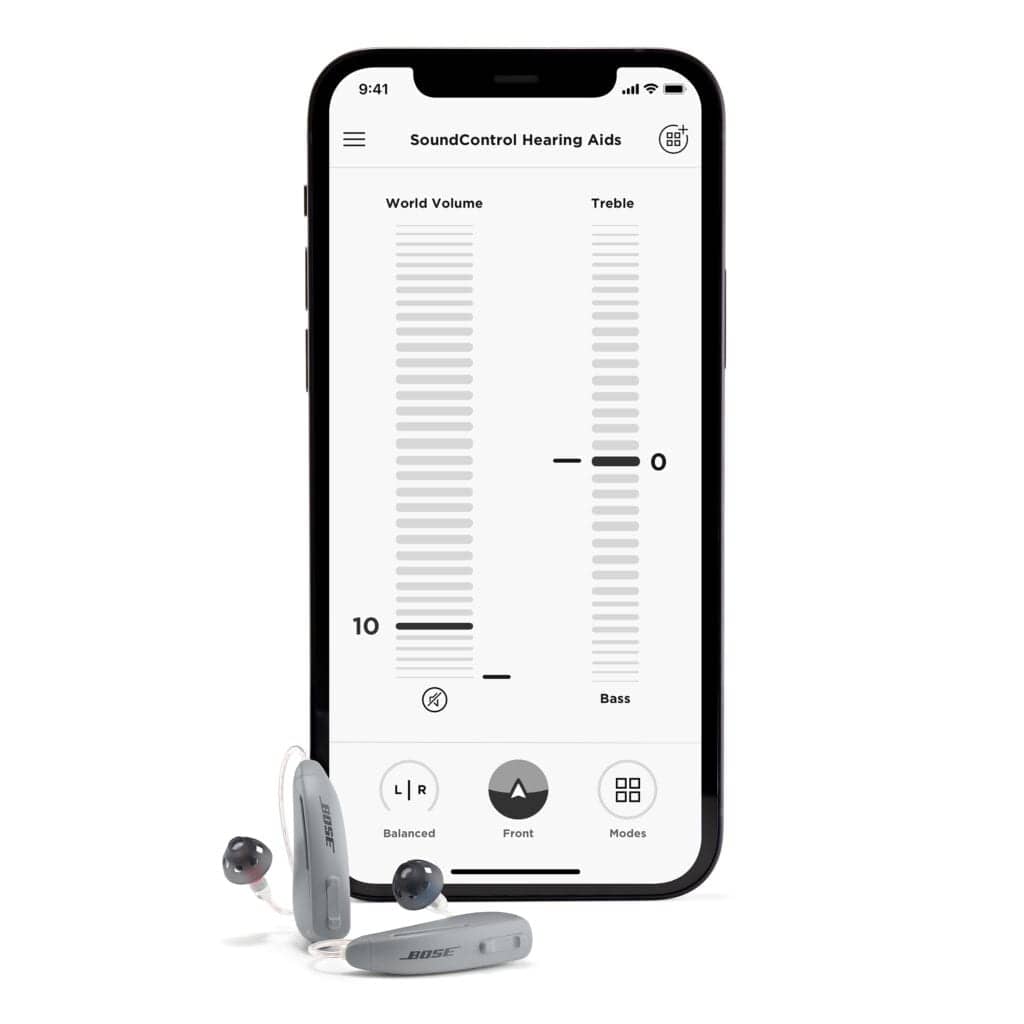Updated May 10, 2021
Bose Corp, Framingham, Mass, has announced the launch of its much-anticipated self-fitting hearing aid—the first of its kind to get FDA clearance. The Bose SoundControl™ Hearing Aids are intended “to amplify sound for individuals 18 years of age or older with perceived mild to moderate hearing impairment.” The devices are adjusted by the user, and no preprogramming or hearing test is necessary. They are intended for direct-to-consumer (DTC) sale and use without the assistance of a hearing care professional and will be offered at $849.95 for a binaural set, come with a 90-day trial, and are eligible for FSA and HSA reimbursement. Bose says the SoundControl™ Hearing Aids will initially be available on a limited geographic basis, with expanded availability in the United States within the coming year.
The new hearing aid does not stream music or take phone calls directly from a cellphone. It’s apparent Bose engineers have taken special note of online competitors’ streaming challenges and battery life issues, with a goal of giving SoundControl hearing aids longer usage times. The SoundControl aid employs a Size 312 zinc-air battery and features LE Bluetooth technology for control of the app and pairing with the devices only. “With typical usage, Bose SoundControl™ Hearing Aids will get up to 56 hours of runtime,” says the company’s website. “Each battery can provide up to 4 days of use, assuming you use both hearing aids for 14 hours per day. Battery life may vary by battery brand, age, frequency of use, or if you only use a single hearing aid.”
Related Article: Comparing Population Coverage between Hearing Aids Using Presets vs Bose CustomTune™
The Bose Hear app, which is reportedly compatible with any iOS and Android devices (Bluetooth 4.2 or later) acts as the control center for the new hearing aid and features the two wheels previously available in the Bose Hearphones. According to its website, Bose CustomTune™ technology “lets you customize your hearing aids with audiologist quality results. The clinically proven technology helps you adjust your hearing parameters within the Bose Hear App using two simple controls: World Volume and Treble & Bass. This technology offers hundreds of options to customize your hearing.” The new aid uses a unique system for programming the gain frequency responses and is designed to provide clinically appropriate amplification settings for older adults with mild-to-moderate hearing loss. Part of the system will be detailed in an article in the June 2021 edition of The Hearing Review.
The app is required for first-time set up of the device and fine-tuning adjustments. It also contains a “Focus” feature for switching from an omni (Everywhere) to directional (Front) microphone mode, and “Left/Right Ear Balance” feature for increasing right and left volume. Additionally, a toggle switch on each hearing aid can control “World Volume” up and down by 5 steps simultaneously in both aids. Pre-set modes include Focused Conversation, Outdoors, Music, and Television, and these modes can be adjusted in the app according to the user’s listening preference, then saved for later use.
Bose SoundControl Hearing Aids feature a behind-the-ear, receiver-in-canal design and are designed to deliver natural, lifelike audio. Each weighs 3 grams and contains two microphones, one tiny speaker, and a standard 312 zinc-air battery. For added protection, SoundControl Hearing Aids are water-resistant to survive light exposure to rain or water and come with a small case for storage and transport.
“In the United States alone, approximately 48 million people suffer from some degree of hearing loss that interferes with their life. But the cost and complexity of treatment have become major barriers to getting help,” said Brian Maguire, category director of Bose Hear in a press statement. “The Bose Hear app lets owners set up and customize their SoundControl Hearing Aids from home—in less than an hour—to reconnect with the moments that matter. That’s an amazing advancement the industry has been missing and nothing short of a breakthrough.”
The “Bose Hearing Aid” was reviewed under the FDA’s De Novo premarket review pathway, a regulatory pathway for some low- to moderate-risk devices that are novel and for which there is no prior legally marketed device, and the Agency granted marketing authorization of the Bose Hearing Aid device in October 2018. The FDA’s description of this new category is: “A self-fitting air-conduction hearing aid is a wearable sound amplifying device that is intended to compensate for impaired hearing and incorporates technology, including software, that allows users to program their hearing aids. This technology integrates user input with a self-fitting strategy and enables users to independently derive and customize their hearing aid fitting and settings.” On April 5, Bose filed a 510k with the FDA for clearance to sell the new Bose SoundControl™ hearing aids and received FDA clearance to go to market with the device on May 5.
Related Blog: Gleanings from Bose Leaders about the Bose Hearing Aid (October 2018)
The new Class II self-fitting classification within hearing aids should not be confused with the still-to-come Over-the-Counter (OTC) Hearing Aid classification that FDA is developing (ie, in terms of FDA regulations, OTC hearing aids do not yet exist). The OTC Hearing Aid Act was passed by Congress and signed into law by President Trump in August 2017 as part of the FDA Reauthorization Act of 2017 (FDARA). It is designed to provide better affordability and accessibility for adults with perceived mild-to-moderate hearing loss, and give them access to OTC hearing aids without being seen by a hearing care professional. It remains to be seen how this self-fitting category will fit in with the pending OTC category of hearing aids.
Guides for Choosing a Hearing Aid and Talking about Hearing Loss with a Loved One
The Bose website also offers the company’s “Guide to Choosing a Hearing Aid” that features explanations about PSAPs vs Hearing Aids, FDA clearance, considerations in purchasing a hearing aid, and a 5-minute online hearing screener.
“Direct-to-consumer hearing aids are changing the way people take care of their hearing,” states the part of the guide titled Putting You in Control. “Sold both online and in store, direct-to-consumer hearing aids put you in control with a hearing solution because they’re more accessible, more convenient to purchase, and more affordable. If you need technical help (or have questions about how to set up and use your hearing aids), video chats, online apps, and access to hearing and/or product experts give you the support you need when it’s convenient for you.”
The Bose website also contains a fairly extensive section on “How to Talk to a Loved One about Their Hearing Loss” that includes tips for listening, making a plan, goal setting, road-block behaviors and solutions, and more.
About the author: Karl Strom is editor of The Hearing Review and has been reporting on hearing healthcare issues for over 25 years.










I am very interest in this.
I have some questions.
1. Will I be able to answer phone calls on me cell phone with this hearing aid?
2. My hearing is less in my left ear will the adjustment with the app help me with the levels?
3. Will it help me hear the pronunciation of the words better?
To the best of my knowledge: 1) No, the product currently does not offer wireless streaming which was a surprise to the hearing industry. My guess is a later product version will; 2 & 3) The app, which is based on the Ear Machine app, should provide you with a reasonable starting point for your hearing loss and there is some adjustability to it. To learn probably more than you want to about the app, you can read this article by Andrew Sabin of Bose and colleagues. Of course, I do recommend that you see a hearing care professional for the best personalized hearing care solution and/or rule out any other medical/auditory issues you might have.
Where can I buy them
Iam in the s hills of Pittsburgh pa
I believe the only way you can buy them is via the Bose website.
It’s about time. These rip off artists are finally getting their come-up pence. They will experience the same as the optometrist did 25 years ago when even readers could only be got by prescription. The audiologist (what a joke) is used to making a killing and now will either cut prices or fall by the wayside. Good riddance.
Seems to be a lot of self interest here, by those that are charging at least 20 times what the aid actually costs.
Most of my patients will be lost with this technology. Who is going to maintain it? Good Luck. Lots of returns I’m assuming.
Good luck Bose, Apple and the rest…be prepared for customer service overload and returns. What’s the trial , warranty and L & D polices?
Audiologist quality? All is see is that you can adjust volume, balance, and tone. Did I miss something? How about 12 or 20 band adjustments to a hearing profile, that can be adjusted by a cell phone app by the consumer? That’s what will be a game changer. ZZZzzz…
The arrogance of BOSE is just stunning. —-“audiologist quality fitting”? —this is deceptive advertising and grounds for a lawsuit.
Twenty years of wearing hearing aids, the hearing aide market is like the used car market. 80 percent of hearing are programed to fit in drawer.
Real ear measurement and best practices ought to be the law.